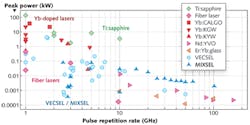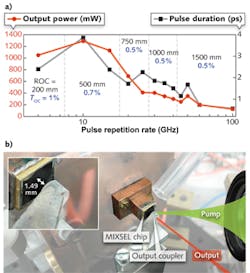VCSELs: MIXSEL: Ultrafast goes simple
MARIO MANGOLD, CHRISTIAN A. ZAUGG, SANDRO M. LINK, ALINE S. MAYER, MATTHIAS GOLLING, BAUKE W. TILMA, and URSULA KELLER
Most short-pulsed diode-pumped solid-state lasers used today are based on semiconductor saturable-absorber mirror (SESAM) modelocking, with important industrial applications ranging from optical communication and precision measurements to microscopy, ophthalmology, and micromachining.1 Recent work has expanded this pulse-generation approach to a new class of semiconductor lasers using wafer-scale integration of both the gain and the absorber into a vertical emitting structure, allowing the technology to potentially scale into high-volume markets. The first demonstration was in 2007 and referred to as the modelocked integrated external-cavity surface-emitting laser (MIXSEL).2
The MIXSEL is part of the family of semiconductor disk lasers (SDLs) or vertical-external-cavity surface-emitting lasers (VECSELs). Optically pumped VECSELs can generate multiwatt average output power in the wavelength regime ranging from 650 nm to more than 2.2 μm using quantum-well (QW) and quantum-dot (QD) bandgap engineering in different III-V semiconductor material systems.
The thin SDL medium in combination with the external cavity not only ensures an excellent output beam quality, but also allows for integration of different linear and nonlinear elements into very compact cavity designs. For instance, intracavity second-harmonic generation gives access to the visible and UV wavelength range at unprecedented output powers.3 An intracavity SESAM provides stable pulse generation with multiwatt average output power.4 Moreover, single- and dual-frequency operation as well as intracavity terahertz generation have been achieved, showing the reliability and versatility of the SDL technology.5-7
Optically pumped VECSELs with intracavity frequency conversion have been successfully commercialized by Coherent Inc. (Santa Clara, CA) with its optically pumped semiconductor laser (OPSL) product portfolio. In contrast to diode-pumped solid-state lasers, a much broader range in operation wavelength can be generated in an OPSL and still maintain low noise performance.
We believe that the optically pumped MIXSEL technology can lead to a new product family for picosecond and femtosecond pulse generation with multiwatt average output power (see Fig. 1), broad wavelength flexibility, and close to quantum-noise-limited performance with gigahertz pulse repetition rates.8,9 The single wafer integration of the gain and absorber layers enables a simple straight linear cavity where the cavity length can be adjusted for pulse repetition rates ranging from about 1 GHz to more than 100 GHz for telecom, datacom, and frequency-comb applications and with a folded linear cavity ranging even to lower megahertz pulse repetition rates for medical and bio-optical applications.10
SESAM-modelocked VECSELs
The MIXSEL was developed from passively modelocked VECSELs using an additional intracavity SESAM in a V- or Z-shaped cavity configuration. The saturable absorption of either QWs or QDs inside a SESAM starts and stabilizes passive modelocking. Graphene saturable absorbers at this point show only limited performance because of damage.11
In contrast to ion-doped solid-state lasers, a more careful balance of the dynamic gain saturation and a loss saturation at lower pulse fluence (pulse energy per area) must be achieved to keep open a net gain window for pulse formation in the semiconductor laser. This is not an issue for ion-doped solid-state lasers because the gain exhibits no significant dynamic gain saturation and is simply saturated to a time-independent value for a given intracavity average power. The pulses then only saturate the absorber for a limited time to open a net gain window that supports short pulse generation or stabilizes soliton modelocking. Thus, for stable pulse generation in SDLs, a low absorber saturation fluence and fast absorption recovery dynamics are required.
The first femtosecond VECSEL with greater than 1 W average power was demonstrated in 2011; more recently, the performance of SESAM-modelocked VECSELs was further improved by other groups, resulting in devices that generated 400 fs pulses with 3.3 W average output power at 1.67 GHz repetition rate or 682 fs pulses with a 5.1 W average output power at 1.7 GHz.12-14
MIXSEL: The next integration step
The MIXSEL represents the next step in reducing complexity and cost. By integrating the saturable absorber of the SESAM into the gain structure of a VECSEL, the laser setup is reduced to two cavity components: the output coupler (OC) and the semiconductor chip. A straight linear cavity with only two components makes this laser very stable and simple to operate (see Fig. 2a) and supports a large range of cavity lengths, where the pulse round-trip time determines the pulse repetition rate.The gain chip is pumped by commercially available high-power diode arrays converting a low quality multimode continuous-wave (CW) pump beam into a fundamental Gaussian output beam with picosecond or femtosecond pulses. Figure 2b illustrates the most recent MIXSEL semiconductor structure operating at a center wavelength of around 960 nm. The single-layer saturable absorber is placed in between a distributed Bragg reflector (DBR) for the lasing wavelength (in this case, about 960 nm) and a DBR for the pump wavelength (approximately 808 nm).
The active region is based on 10 QWs that are embedded in pump-absorbing barriers. An optimized antireflection (AR) section on top of the MIXSEL wafer minimizes reflection losses and ensures a flat and low group-delay dispersion for short pulse generation. For efficient heat extraction and high-power operation, the structure is grown in reverse order and then flip-chip bonded to a diamond heat spreader. The wafer substrate is removed wet-chemically.
For stable passive modelocking of semiconductor lasers, the saturable absorber has to saturate at lower pulse fluences than the gain QWs to open a net gain window in which the pulse formation can take place. In SESAM-modelocked VECSELs, this is typically achieved by adjusting the ratio between the laser mode radii on the gain and the SESAM. However, in a MIXSEL the laser mode areas are identical in the gain and absorber regions.
A resonant MIXSEL design (as demonstrated in 2007) generates such a net-gain window with a subresonator to enhance the electric field at the position of the absorber layer with respect to the active gain layers.2 This design, however, has many trade-offs, and it is much more advantageous to use an antiresonant MIXSEL design, where the field enhancement in the gain and the absorber are about the same. This required special absorber optimization to reduce the saturation fluence compared to the gain layers, which was initially obtained with a QD absorber layer.
This resulted in a record-high average output power of 6.4 W, but at the expense of longer picosecond pulses (28 ps pulses at 2.5 GHz repetition rate) because the integrated QD saturable absorber became slow during the annealing in the long growth by molecular-beam epitaxy. Reducing the linear cavity length enabled 10 GHz pulse repetition rates while still producing 2.4 W of average output power in 17 ps pulses.
Most recently a novel QW absorber was developed that exhibits both a low saturation fluence and a very fast recovery time even after annealing. This resulted in the latest MIXSELs that supported a drastic reduction in pulse duration. With this recent high-power MIXSEL, the pulse repetition rate was scaled from about 5 GHz to more than 100 GHz (see Fig. 3a) by stepwise reduction of the cavity length and adapting the output coupler accordingly. Up to 15 GHz watt-level operation in sub-4 ps pulses was obtained.In addition, stable femtosecond operation at pulse repetition rates of 60 GHz and 101.2 GHz was achieved, representing the highest pulse repetition rate of any fundamentally modelocked SDL and also the shortest pulses from a MIXSEL to date (see Fig. 3b). The MIXSEL technology therefore provides the highest average output power and highest peak power of any fundamentally modelocked laser between 15 GHz and 100 GHz.8
In addition, a detailed noise characterization of a picosecond MIXSEL confirmed that, with an integrated root-mean-squared (RMS) timing jitter of less than 70 fs integrated over 1 Hz to 100 MHz and an RMS amplitude noise of less than 0.15% (1 Hz to 40 MHz), high-power modelocked SDLs can have a noise performance comparable to conventional ion-doped gigahertz solid-state lasers.9
We believe that the optically pumped MIXSEL has a bright future as commercial products in the SDL family have a proven track record with the OPSL from Coherent Inc. and the VCSELs used today in a broad range of applications. Optical pumping is ideally suited for power scaling into the multiwatt-average-power regime. Electrical pumping could reduce the pump complexity, but will come at the expense of average output power because there is an intrinsic trade-off between optical and electrical losses.15
ACKNOWLEDGEMENTS
The authors acknowledge support of the technology and cleanroom facility FIRST of ETH Zurich for advanced micro- and nanotechnology. This work was financed by the Swiss Confederation Program Nano-Tera.ch, which was scientifically evaluated by the Swiss National Science Foundation (SNSF).
REFERENCES
1. U. Keller, Appl. Phys.B, 100, 15–28 (2010).
2. D. J. H. C. Maas et al., Appl. Phys.B, 88, 493–497 (2007).
3. S. Calvez et al., Laser Photon. Rev., 3, 407–434 (2009).
4. U. Keller et al., Phys. Rep., 429, 67–120 (2006).
5. A. Laurain et al., IEEE Photon. Technol. Lett., 26, 131–133 (2014).
6. F. A. Camargo et al., IEEE Photon. Technol. Lett., 24, 1218–1220 (2012).
7. M. Scheller et al., Opt. Exp., 18, 27112–27117 (2010).
8. M. Mangold et al., Opt. Exp., 22, 6099–6107 (2014).
9. M. Mangold et al., IEEE Photon. J., 6, 1–9 (2014).
10. C. A. Zaugg et al., Opt. Exp., 20, 27915–27921 (2012).
11. C. A. Zaugg et al., Opt. Exp., 21, 31548–31559 (2013).
12. M. Hoffmann et al., Opt. Exp., 19, 8108–8116 (2011).
13. K. G. Wilcox et al., Opt. Exp., 21, 1599–1605 (2013).
14. M. Scheller et al., Electron. Lett., 48, 588–589 (2012).
15. Y. Barbarin et al., IEEE J. Select. Topics Quantum Electron., 17, 1779–1786 (2011).
Mario Mangold, Christian A. Zaugg, Sandro M. Link, Aline S. Mayer, Matthias Golling, Bauke W. Tilma, and Ursula Keller work in the Ultrafast Laser Physics (ULP) group at ETH Zurich, Auguste-Piccard-Hof 1, 8093 Zurich, Switzerland; e-mail: [email protected]; www.ulp.ethz.ch.


